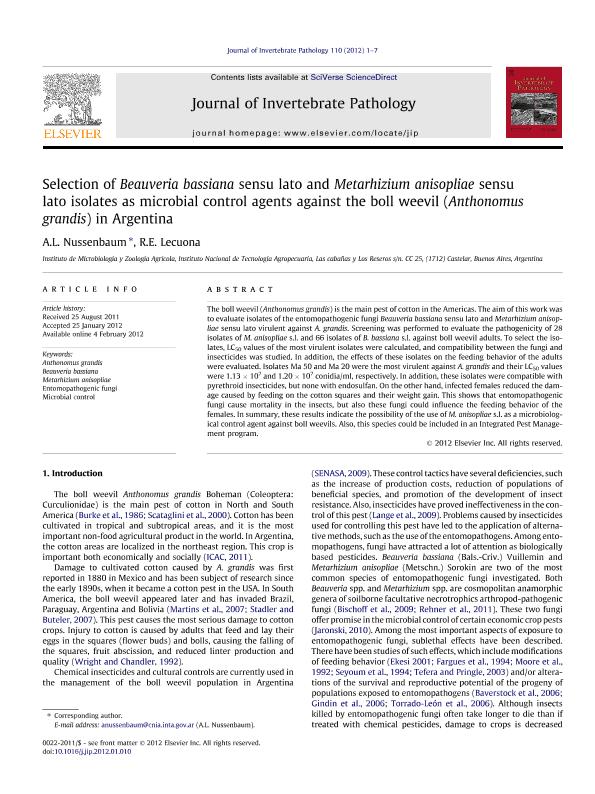Artículo
Selection of Beauveria bassiana sensu lato and Metarhizium anisopliae sensu lato isolates as microbial control agents against the boll weevil (Anthonomus grandis) in Argentina
Fecha de publicación:
01/2012
Editorial:
Academic Press Inc Elsevier Science
Revista:
Journal of Invertebrate Pathology
ISSN:
0022-2011
Idioma:
Inglés
Tipo de recurso:
Artículo publicado
Clasificación temática:
Resumen
The boll weevil (Anthonomus grandis) is the main pest of cotton in the Americas. The aim of this work was to evaluate isolates of the entomopathogenic fungi Beauveria bassiana sensu lato and Metarhizium anisopliae sensu lato virulent against A. grandis. Screening was performed to evaluate the pathogenicity of 28 isolates of M. anisopliae s.l. and 66 isolates of B. bassiana s.l. against boll weevil adults. To select the isolates, LC 50 values of the most virulent isolates were calculated, and compatibility between the fungi and insecticides was studied. In addition, the effects of these isolates on the feeding behavior of the adults were evaluated. Isolates Ma 50 and Ma 20 were the most virulent against A. grandis and their LC 50 values were 1.13×10 7 and 1.20×10 7 conidia/ml, respectively. In addition, these isolates were compatible with pyrethroid insecticides, but none with endosulfan. On the other hand, infected females reduced the damage caused by feeding on the cotton squares and their weight gain. This shows that entomopathogenic fungi cause mortality in the insects, but also these fungi could influence the feeding behavior of the females. In summary, these results indicate the possibility of the use of M. anisopliae s.l. as a microbiological control agent against boll weevils. Also, this species could be included in an Integrated Pest Management program.
Archivos asociados
Licencia
Identificadores
Colecciones
Articulos(SEDE CENTRAL)
Articulos de SEDE CENTRAL
Articulos de SEDE CENTRAL
Citación
Nussenbaum, Ana Laura; Lecuona, R. E.; Selection of Beauveria bassiana sensu lato and Metarhizium anisopliae sensu lato isolates as microbial control agents against the boll weevil (Anthonomus grandis) in Argentina; Academic Press Inc Elsevier Science; Journal of Invertebrate Pathology; 110; 1; 1-2012; 1-7
Compartir
Altmétricas




